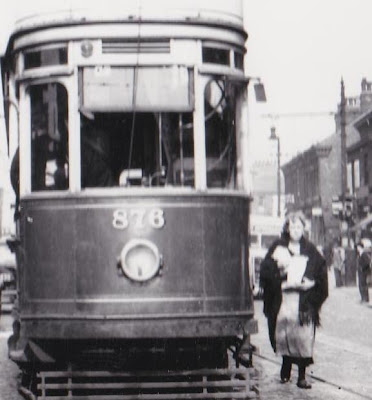We are in Hollinwood in the summer of 1938.
And if I have got this right car 878 is travelling south from Oldham and maybe about to go in to the tram terminus which is off to our left.
Now I have to confess I don’t know Hollingwood but using the picture and the OS map for 1935* I am pretty sure that is where we are.
Now that may well open me up to be shot down within minutes of people seeing the story, but so be it.
“The area was initially largely occupied by workers in Oldham's cotton mills and miners at the large collieries at Oak and Bower, and several smaller ones. Much of Hollinwood's more recent growth was due to the Ferranti factory which produced power transformers in its heyday. Later the factory produced container lifting trucks as the building had the height to do so. The transformer works building, built after the war on the old Bower site, is now used as a newspaper printing plant. A neighbouring, much older, Ferranti factory produced electricity meters. The meter factory was sold to Siemens in the 1980s and became known as FML; Siemens later closed the FML factory.”**
All of which is captured in the detail on the picture.
August 2nd when the photograph was taken was a Tuesday and where we are standing was always a busy spot.
Beyond Oldham Corporation’s Tramway Depot was the large engineering works, while behind the White Hart Hotel was the gas works, the Rose Mill specialising in cotton waste, the Windsor Mill making India Rubber waterproofing and the three cotton mills of Lime Mill, Albert Mills and Hollinwood Mill.
Completing this industrial scene running in from Ashton was the Manchester and Ashton-under-Lyne Canal which terminated at the Bradley Bent Basin a little to the north east of the hotel.
 |
| Shawl, apron and that tram |
So despite the growing use of vans and lorries, there were still a reliance on horse drawn vehicles and the old stately rattling tram cars.
These trams would last well into the next decade but by the end of the 1940s they were no more.
In much the same way so would the shawl that all too typical piece of woman's clothing.
And so I am drawn to the women in the shawl and apron.
She would not have looked out of place at any time in the century before the picture was taken but I very much doubt that shawls survived much beyond the end of the last world war on the streets of Hollinwood.
And that pretty much brings us up to date.
The White Hart Hotel is still there, although it has lost its chimneys and the long roof sign advertising its name and the brewery and acquired a white plastered exterior.
But even more than that it stands amongst relatively new social housing which are fronted by wide open green banks and plenty of trees. What is missing is all that industrial landscape.
Looking at pictures of the place today especially in the sunshine it is hard to make the connection with our grimy busy scene in the August of 1938.
Pictures; from the collection of Alan Brown
*http://enriqueta.man.ac.uk/luna/servlet/detail/maps2~1~1~342544~123252:Manchester-bomb-damage?sort=Reference_Number%2CPage%2CCurrent_Repository
**Wikipedia, http://en.wikipedia.org/wiki/Hollinwood,_Greater_Manchester



No comments:
Post a Comment